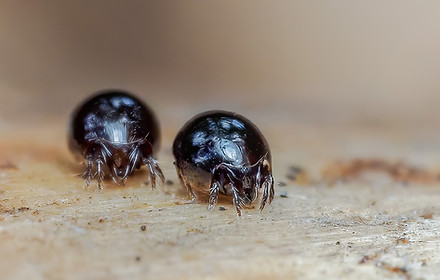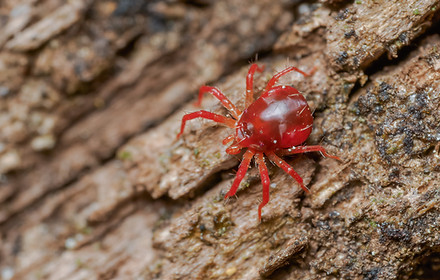Small World Discoveries
by Tony Enticknap - tickspics
Focusing on insects, arachnids and other small nature subjects from East Dorset and the New Forest ...
ACARI | Mites and Ticks
Mites are tiny, mostly microscopic creatures that go about their daily business pretty much unnoticed.
You may see the odd mite if you're out in the woods looking for ground-dwelling insects or other small arthropods, but unless one of the larger more brightly coloured prostigmatid species catches your eye, or you manage to pick up a tick from laying in leaf-litter, it's unlikely that you'd give this particular group of species a second thought.
I certainly hadn't until I started taking notice of the strange-looking beasts that would occasionally appear in my peripheral vision whilst photographing springtails - mysterious and barely discernible one minute and then wonderfully intriguing the next as they slowly came into focus.
When you see a mite for the first time that is dwarfed in size by a springtail, you'd be forgiven for thinking that trying to photograph them would be a challenge too far. And sometimes it is, because they can certainly be incredibly difficult to spot with the naked eye and, in most cases, tricky to photograph even with higher magnification optics. However, if you're like me, and enjoy grubbing around on the ground discovering what can be found in the soil and leaf-litter or on the underside of deadwood, then they're definitely fascinating subjects that shouldn't be ignored.
My personal interest in mites has really grown during the course of researching and writing up this section, which is reflected in the content and the fact that it was originally going to be no more than a handful of selected photos with minimal text, but has now ended up being something much bigger. It's a bit of an ambitious undertaking as it's always difficult researching a subject such as mites that are both poorly supported and generally considered as being one of those groups of species that should be left to the experts. I've lost count of the times I've been told that mites are outside the scope of casual observation as specimens should be prepared and studied under a microscope rather than through a viewfinder.
Of course there are limits of what you can expect to find and photograph as noted below, but that shouldn't stop you trying and it certainly shouldn't put you off learning about mites. Despite all of the inherent problems I've encountered along the way I've enjoyed the process and now feel confident enough to share my photos and some of the knowledge I've acquired.
In that respect, there are two particular aspects that I want to cover in sufficient detail to ensure that the information is readily available here for future reference. The first is an overview of the way mites are taxonomically classified, which needs to be understood in order to determine any level of identity. The other, not surprisingly, is to include any useful notes regarding the families and species that I've found, especially relating to visible features that be seen in photos rather than finer details that can only be determined through close examination. I also wanted to include a note regarding where the different species had been photographed and, by that, I'm referring to the habitat and substrate on which they were found as well as the location.

Oribatida > Euzetes globulus - 'black helmet mite'

Prostigmata > Anystis sp. - 'whirligig mite'
Disclaimer .....
Before we explore mites in more detail, please remember that all of this information is from a photographer's perspective as noted below; hopefully accurate and duly qualified where necessary, but always with the possibility of misinterpretation or incorrect identification. The content will be regularly reviewed and updated when new species or photos are added, but it would obviously be useful to know if an error is spotted, so please do not hesitate in making contact.
Classification and appreciating the limitations .....
There's no quick and easy way of explaining the complex, multi-layered classification system, but it can be simplified to some degree if it's broken down, which is what I've attempted to do here. The first stage is to understand how the species are segregated into specific groups, but before we get to that point, it has to be appreciated that identification from photos will only be possible to a certain level even with expert help and, in many cases, that may just be to the family. There are a few exceptions particularly with the Oribatida where it might be possible to determine the genus or even the species, but taking the group as a whole they are few and far between.
Forgetting the odd larger species, most of the mites you're going to try photographing will likely be somewhere in the region of say 700µm to around 1.5 to 2mm body length. At that size, it's difficult to capture detail due to focus, depth of field, light, positioning and so on, but also the species and how it's behaving. Some move slowly, whilst others tear around and never pause for more than a second. If I find a sedentary or slowly moving species, I will usually ensure I take plenty of photos from as many different angles that I can, but with some, such as the whirligig mites, it's a case of taking what photos you can and hope you've got a couple in focus. The other problem is down to eyesight and if you're short-sighted and wear glasses like me, it can be an issue. I generally find that I can only spot small oribatid mites if I get close and take my glasses off, but I then have to put them back on to use the camera, following which I have to remember where the mite was!
Obviously, those problems are all part of the challenge, the same as trying to get to grips with the taxonomy. Luckily though, we don't need to dig too deep as the intermediate rankings are of limited value, but we do need a basic knowledge of the way the different types of species we're likely to encounter are classified.
The starting point is to understand that the ACARI has two primary divisions ACARIFORMES and PARASITIFORMES which were regarded as super-orders, but are now being considered as totally separate lineages that should be reclassified as orders. There's also a growing view that whilst the name ACARI has been traditionally regarded as a subclass of ARACHNIDA it is now no more than a generic term for mites rather than an official taxon. Fortunately, these potential changes would only have a bearing on the taxonomic rankings not the systematic arrangement itself where the primary divisions and lower ranked taxons are mostly stable.
ACARIFORMES is split into the Sarcoptiformes and Trombidiformes, which are subsequently divided into three suborders with the two major groups noted below being separately divided into three further intermediate rankings previously known as cohorts, but now redesignated as infraorder, hyporder and parvorder. Those ranking would be affected if the primary division was regraded, but at the moment they're correct.
The important mite groups here are Sarcoptiformes > Oribatida, and Trombidiformes > Prostigmata.
Sarcoptiformes also includes Endeostigmata which are a primitive group of tiny, rarely recorded species.
To avoid unnecessary references at this stage I've deliberately avoided mentioning superfamilies, but they are confirmed in each section header on the following pages. The highlighted order/suborder together with the family and, where possible, the genus and/or species are the main identifiers.
Oribatida
'armoured soil mites'
Prostigmata
'sucking mites'
PARASITIFORMES is split in a similar way, but with one less layer of complexity as the lower taxon parvorder is not used.
Our interest here is with Mesostigmata and Ixodida, which have the same taxonomic ranking as Sarcoptiformes and Trombidiformes in that they're currently recognised as orders.
Each thumbnail links to a designated page with information about that particular group and notes regarding the families and species I've photographed.
Mesostigmata
'predatory and parasitic mites'
Ixodida
'ticks'
General description .....
Notwithstanding any of the specific features that relate to a particular group, mites can generally be described as minute to tiny arachnids that mostly have a body size somewhere in the region of 200µm to 600µm, with only a small number of species that grow larger. And, of course, it's the larger species that feature here. They are typically in the region of 700µm to around 2mm as previously noted, but there are a few varieties, such as some of the velvet mites, that are comparatively much bigger.
The principal difference that separates mites from some of the superficially similar tiny spiders you see, are that they don't have any visible segmentation of the body. Accordingly, the familiar arachnid terms of cephalothorax and abdomen are replaced here with gnathosoma, being the moveable section at the front containing the mouthparts and pedipalps and, behind that, the idiosoma, which is the main part of the body. The gnathosoma may be called the head but, in the true sense, it's not as it doesn't contain the eyes or a brain. In fact, whilst some mites have a pair, or even two pairs, of median or lateral eyes, many species are blind. The actual shape and form of the body, together with the degree of sclerotisation, varies between the groups. Similarly, with the way the different species breath, which could be directly through the cuticle (Oribatida) or via holes in the exoskeleton called stigmata. The stigmata are often associated with a tube or gutter-like channel known as the peritreme that are either located on the side (Mesostigmata) or around the front (Prostigmata). As with all arachnid species, adult mites typically have four pairs of legs, but the larvae are usually hexapodal (six-legged) only acquiring the full complement during the nymphal stage of development.
Created July 25 | updated Aug.25 (v.3)



